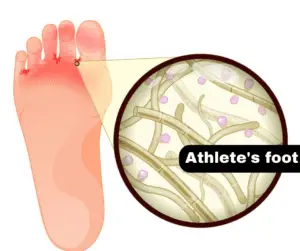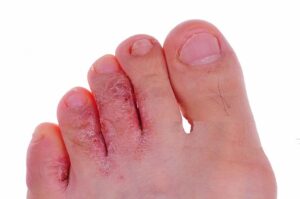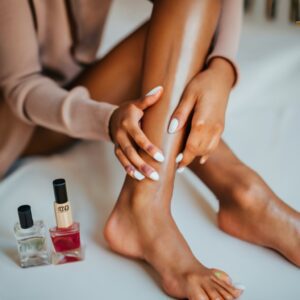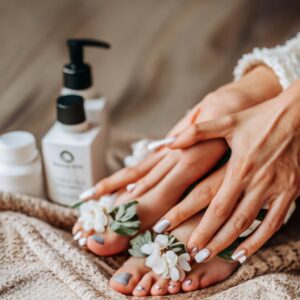
Athlete’s foot, clinically known as tinea pedis, is a common fungal infection that primarily affects the skin on the feet. This condition, though often viewed as a mild inconvenience, demands prompt attention due to its potential to cause discomfort and complications if left untreated.
Defining Athlete’s Foot:
Athlete’s foot is a fungal infection caused by various types of fungi, most commonly thriving in warm and moist environments. These fungi can be easily contracted in communal spaces like locker rooms, swimming pools, or shared showers. The infection is highly contagious and can spread through direct contact or by coming into contact with contaminated surfaces.
The Urgency of Addressing Athlete’s Foot:

Addressing athlete’s foot promptly is crucial for several reasons. Firstly, the symptoms, including itching, redness, and discomfort, can escalate if the infection is allowed to progress. Secondly, the fungus responsible for athlete’s foot can potentially spread to other parts of the body, leading to more widespread infections.
Additionally, ignoring athlete’s foot increases the risk of complications such as bacterial infections. The cracked and peeling skin associated with athlete’s foot creates openings for bacteria to enter, causing secondary infections that can be more challenging to treat.
Beyond the physical discomfort, athlete’s foot can also impact one’s quality of life. The persistent itching and irritation can be a source of frustration, affecting daily activities and even sleep. Furthermore, the potential for the infection to spread to others makes it a public health concern, emphasizing the need for swift and effective intervention.
In the subsequent sections, we’ll delve deeper into the causes, symptoms, prevention, and treatment options for athlete’s foot. By gaining a comprehensive understanding of this condition, individuals can make informed decisions to address it promptly and effectively, ensuring a quicker return to comfort and overall well-being.
causes and Risk Factors: Unveiling the Origins of Athlete’s Foot

Athlete’s foot, a common fungal infection affecting the feet, has its roots in the microscopic world of fungi. Understanding the causes and risk factors is pivotal in both preventing and managing this condition effectively.
Fungi Responsible for Athlete’s Foot:
Athlete’s foot is primarily caused by fungi known as dermatophytes. These fungi thrive in warm and moist environments, creating an ideal breeding ground for their growth. The most common culprits include Trichophyton mentagrophytes and Trichophyton rubrum. These fungi are highly contagious and can be contracted through direct contact with an infected person, contaminated surfaces, or by walking barefoot in shared spaces like locker rooms and communal showers.
Environments Conducive to Fungal Growth:
Several risk factors contribute to the development of athlete’s foot, and understanding these environmental conditions is essential for prevention:
Warm and Moist Areas: Fungi flourish in warm and damp environments. Sweaty feet, especially in tight or closed-toe shoes, provide an ideal setting for fungal growth.
Public Spaces: Places with a high volume of foot traffic, such as public showers, swimming pools, and gym locker rooms, pose an increased risk. The fungus can linger on surfaces like floors and mats, making it easy to pick up.
Improper Foot Hygiene: Inadequate cleaning and drying of the feet, particularly between the toes, create an environment conducive to fungal infections.
Wearing Tight Footwear: Shoes that do not allow proper ventilation and trap moisture contribute to the development of athlete’s foot.
Weakened Immune System: Individuals with compromised immune systems are more susceptible to fungal infections, including athlete’s foot.
Preventing Athlete’s Foot:

Preventing athlete’s foot involves minimizing exposure to these risk factors. Practicing good foot hygiene, wearing breathable footwear, and avoiding prolonged exposure to damp environments are crucial steps. Additionally, wearing flip-flops or sandals in communal areas can act as a protective barrier.
Signs and Symptoms: Decoding the Language of Athlete’s Foot
Athlete’s foot manifests through a spectrum of symptoms, offering vital clues to its presence. Understanding these signs is instrumental in early detection and effective management, as the presentation can vary in both form and intensity.
Itching (Pruritus):
Commonly the Initial Warning
Athlete’s foot often announces its arrival with persistent itching, especially between the toes. This itching can extend to the soles of the feet and the sides, creating an uncomfortable and distracting sensation.
Redness and Scaling:
Unveiling the Inflammatory Response
The affected skin typically exhibits redness, and the outer layers may start to peel or flake. This redness can spread, outlining the contours of the infection.
Blistering:
Fluid-Filled Indicators
In some cases, athlete’s foot can lead to the formation of blisters filled with fluid. These blisters, though not always present, contribute to heightened discomfort and are prone to breaking, potentially leading to further irritation.
Cracking and Peeling:
Signs of Skin Breakdown
The skin affected by athlete’s foot may crack or peel, particularly between the toes. This can expose raw areas, making the skin susceptible to secondary bacterial infections.
Burning or Stinging Sensation:
Adding Discomfort to the Itch
A burning or stinging sensation may accompany the itching, intensifying the overall discomfort experienced by the individual.
Odor:
Unpleasant Consequence
Athlete’s foot can be associated with an unpleasant odor, especially when blisters or open sores are present. The combination of fungal infection and bacterial growth contributes to this distinctive smell.
Variations in Presentation:
Athlete’s foot doesn’t always follow a uniform pattern. Its presentation can vary based on several factors:
Severity: Mild cases may exhibit minimal redness and itching, while severe infections can involve extensive peeling, blistering, and pronounced discomfort.
Location: Athlete’s foot commonly affects the spaces between the toes, but it can also spread to the soles and sides of the feet.
Individual Response: Each person’s immune response differs, influencing the manifestation of symptoms. Some may experience intense itching, while others may notice more visible signs like redness and scaling.
Understanding the diverse ways athlete’s foot can present itself enables individuals to recognize the signs early, facilitating prompt intervention and effective treatment.
Prevention: Shielding Your Feet Against Athlete’s Foot

Preventing athlete’s foot involves adopting proactive measures to create an unwelcome environment for the fungi responsible for this common infection. By prioritizing proper foot hygiene and steering clear of high-risk environments, individuals can significantly reduce their susceptibility to this discomforting condition.
Tips for Preventing Athlete’s Foot:
Keep Feet Clean and Dry: Thoroughly wash your feet with soap and water daily, paying special attention to the spaces between the toes. After washing, ensure your feet are completely dry, as fungi thrive in moist conditions.
Choose Breathable Footwear: Opt for shoes made from breathable materials, such as leather or mesh, to allow proper ventilation. Avoid tight-fitting shoes that can trap moisture and create an ideal environment for fungal growth.
Rotate Shoes: Give your shoes time to air out by rotating them. Avoid wearing the same pair every day, especially if your feet tend to sweat.
Use Antifungal Powders or Sprays: Applying antifungal powders or sprays to your feet and inside your shoes can help create an inhospitable environment for fungi. This is particularly beneficial in high-risk environments.
Avoid Going Barefoot in Public Spaces: Refrain from walking barefoot in communal areas like locker rooms, public showers, and swimming pool areas. Wear flip-flops or sandals to create a protective barrier.
Choose Moisture-Wicking Socks: Opt for socks made from materials that wick away moisture, such as synthetic blends or merino wool. Change socks if they become damp.
Importance of Proper Foot Hygiene:

Regularly Trim Toenails: Keeping toenails short and clean reduces the risk of fungi finding a home under the nails. Trim them straight across to prevent ingrown toenails.
Dry Between Toes Thoroughly: After bathing, make sure to dry the spaces between your toes meticulously. Fungi thrive in areas with retained moisture.
Avoid Sharing Personal Items: Steer clear of sharing items like socks, shoes, or towels, as this can contribute to the spread of fungi.
Avoiding High-Risk Environments:
Be Cautious in Communal Spaces: Exercise caution in places where fungi are likely to thrive. When using communal showers or changing rooms, take preventive measures like wearing protective footwear.
Regularly Disinfect Footwear: If you frequent high-risk environments, regularly disinfect your footwear to eliminate any potential fungal spores.
Who is at Risk? Navigating the Vulnerability to Athlete’s Foot

Athlete’s foot doesn’t discriminate and can affect individuals from all walks of life. However, certain factors can elevate one’s susceptibility to this fungal infection. Understanding who is at risk and recognizing common scenarios leading to infection provides valuable insights for proactive prevention and targeted intervention.
More Susceptible to Athlete’s Foot:
Athletes and Active Individuals: Regular engagement in physical activities, especially those involving sweaty feet and shared spaces like gyms or sports facilities, increases the risk.
People with Compromised Immune Systems: Conditions or medications that weaken the immune system, such as HIV/AIDS or certain immunosuppressive drugs, can heighten susceptibility.
Diabetics: Individuals with diabetes are at an increased risk due to compromised circulation and nerve damage, which can affect the feet.
Those with Excessive Foot Sweating: People prone to profuse sweating, a condition known as hyperhidrosis, create an environment conducive to fungal growth.
Individuals with a History of Fungal Infections: Those who have previously dealt with fungal infections on the feet, nails, or other areas are more susceptible to recurrence.
Common Scenarios Leading to Infection:
Shared Communal Spaces: High-traffic areas like public showers, locker rooms, and swimming pool changing rooms are breeding grounds for fungi. Walking barefoot in these spaces increases the risk.
Wearing Tight or Poorly Ventilated Shoes: Footwear that traps moisture and lacks proper ventilation creates an environment where fungi thrive.
Using Contaminated Items: Sharing socks, shoes, or towels with someone who has athlete’s foot can facilitate the spread of the infection.
Neglecting Foot Hygiene: Inadequate cleaning and drying of the feet, especially between the toes, contribute to the risk of fungal infections.
Warm and Humid Environments: Living in or frequenting areas with warm and humid climates can increase the risk of athlete’s foot.
Treatment Options: Navigating the Path to Fungal Freedom

When athlete’s foot makes an unwelcome appearance, timely and effective treatment becomes paramount. Fortunately, a range of treatment options exists, offering individuals the means to combat this fungal intruder. This section provides an overview of available antifungal medications, delves into the choice between topical treatments and oral medications, and outlines the expected duration of treatment along with potential outcomes.
Available Antifungal Medications:
Topical Antifungals: These medications come in various forms, including creams, ointments, and sprays. Common ingredients include clotrimazole, miconazole, terbinafine, and others. Topical treatments are applied directly to the affected area, penetrating the skin to target the fungal infection.
Oral Antifungals: In cases of more severe or persistent athlete’s foot, oral medications may be prescribed. Oral antifungals such as terbinafine or itraconazole work systemically to address the infection from within.
Topical Treatments vs. Oral Medications:

Topical Treatments:
Advantages: Convenient application, targeted treatment of the affected area, and generally milder side effects.
Considerations: Effective for mild to moderate cases. Consistent and thorough application is crucial for success.
Oral Medications:
Advantages: Systemic approach reaches the infection from within, potentially offering faster and more comprehensive relief.
Considerations: Reserved for more severe cases. Monitoring for potential side effects is essential.
Duration of Treatment and Expected Outcomes:
Topical Treatments:
Duration: Typically applied once or twice daily for several weeks.
Expected Outcomes: Improvement in symptoms such as itching, redness, and scaling. Complete resolution may take a few weeks.
Oral Medications:
Duration: A shorter course, often spanning a few weeks.
Expected Outcomes: Rapid relief of symptoms, with the potential for quicker resolution compared to topical treatments.
General Treatment Guidelines:
Consistency is Key: Adhering to the prescribed treatment regimen is crucial for successful outcomes. Skipping applications or stopping medication prematurely can contribute to recurrence.
Follow-up with Healthcare Provider: Regular check-ins with a healthcare provider during and after treatment ensure progress is monitored, and adjustments can be made if necessary.
Maintain Good Foot Hygiene: Even during and after treatment, practicing good foot hygiene, including keeping the feet clean and dry, helps prevent recurrence.
Home Remedies

A Holistic Approach to Soothe Athlete’s Foot Symptoms
In addition to medical interventions, home remedies offer a complementary and often soothing approach to alleviating the symptoms of athlete’s foot. These natural and accessible methods can be incorporated into a holistic care routine, enhancing the overall effectiveness of treatment. This section explores various home remedies and underscores the pivotal role of maintaining proper foot hygiene in the management of athlete’s foot.
Tea Tree Oil:
Application: Dilute tea tree oil with a carrier oil and apply to the affected area.
Benefits: Exhibits natural antifungal properties and may help reduce itching and inflammation.
Apple Cider Vinegar Soak:
Soak Recipe: Mix one part apple cider vinegar with three parts water. Soak feet for 15-20 minutes.
Benefits: Creates an acidic environment unfavorable for fungal growth. Also helps soothe itching.
Baking Soda Paste:
Paste Recipe: Mix baking soda with a small amount of water to create a paste. Apply to affected areas.
Benefits: Acts as an antifungal agent and may help reduce inflammation.
Garlic:
Application: Crush garlic cloves and mix with olive oil. Apply to the affected area.
Benefits: Garlic contains allicin, known for its antifungal properties.
Coconut Oil:
Application: Apply coconut oil directly to the affected skin.
Benefits: Exhibits antifungal and moisturizing properties.
The Role of Maintaining Proper Foot Hygiene

Regular Cleaning and Drying:
Importance: Cleanse your feet daily with mild soap and water. Ensure thorough drying, especially between the toes.
Use of Antifungal Powders:
Application: Apply antifungal powders to keep the feet dry and inhibit fungal growth.
Benefits: Helps maintain a dry environment, preventing the recurrence of athlete’s foot.
Rotate Footwear:
Practice: Rotate your shoes and avoid wearing the same pair every day.
Benefits: Allows shoes to air out, preventing the buildup of moisture.
Choose Breathable Footwear:
Preference: Opt for shoes made from breathable materials like leather or mesh.
Benefits: Enhances ventilation, reducing the risk of fungal growth.
General Tips for Home Care

Monitor for Signs of Improvement or Worsening:
Observation: Keep track of how your feet respond to home remedies. If symptoms persist or worsen, consult a healthcare professional.
Consultation with Healthcare Provider:
Guidance: Before trying new home remedies, consult your healthcare provider to ensure compatibility with prescribed treatments.
complications

While athlete’s foot is often manageable with home care and over-the-counter treatments, it’s crucial to be aware of potential complications that may arise if the condition is left untreated. This section explores the possible complications and provides clear indications for seeking professional medical help to ensure timely intervention and effective resolution.
Potential Complications if Athlete’s Foot is Left Untreated:
Secondary Bacterial Infections:
Risk: Scratching the affected area may lead to breaks in the skin, creating an entry point for bacteria.
Outcome: Secondary bacterial infections can exacerbate symptoms and require additional medical attention.
Cellulitis:
Risk: Bacterial infections can extend to deeper layers of the skin, causing cellulitis.
Outcome: Cellulitis is characterized by redness, swelling, and warmth and may necessitate oral antibiotics.
Chronic or Recurrent Infections:
Risk: Inadequate treatment or neglecting proper foot hygiene may lead to persistent or recurring fungal infections.
Outcome: Chronic athlete’s foot can be challenging to manage and may require more aggressive medical interventions.
Spread to Other Body Areas:
Risk: Fungal spores can spread to other parts of the body, including the hands and nails.
Outcome: Addressing widespread fungal infections may require a comprehensive approach and medical guidance.
indications for Seeking Professional Medical Help:

Lack of Improvement with Home Care:
Sign: If symptoms persist or show no improvement with home remedies and over-the-counter treatments.
Action: Consult a healthcare provider for a comprehensive evaluation and tailored treatment plan.
increasing Pain, Swelling, or Redness:
Sign: If there is a noticeable increase in pain, swelling, or redness in the affected area.
Action: Prompt medical attention is essential to assess the situation and determine appropriate interventions.
Development of Blisters or Pus:
Sign: If blisters or pus-filled lesions develop, indicating a possible secondary bacterial infection.
Action: Seek medical attention to address the bacterial component and prevent complications.
Fungal Infection Spreading to Nails:
Sign: If the fungal infection spreads to the toenails, leading to discoloration or thickening.
Action: Consult a healthcare provider for specialized treatment options for fungal nail infections.
underlying Health Conditions:
Sign: If there are underlying health conditions such as diabetes or compromised immune function.
Action: Individuals with certain health conditions may require tailored treatment plans and closer medical monitoring.
Athlete’s Foot vs. Other Skin Conditions
Skin conditions can present with overlapping symptoms, making it challenging to pinpoint the specific culprit. This section aims to unravel the dermatological puzzle by distinguishing athlete’s foot from similar skin conditions. Additionally, it provides guidance on when to consult a healthcare professional for a proper diagnosis, ensuring accurate identification and tailored treatment.
Distinguishing Athlete’s Foot from Similar Skin Conditions:
| Skin Condition | Description | Common Locations | Triggers/Causes |
|---|---|---|---|
| Athlete’s Foot | Typically affects spaces between toes, causing itching, redness, and peeling. Fungal infection is common. | Between toes, on soles | Fungal involvement |
| Eczema | May appear on various parts of the foot with red, inflamed, and itchy patches. Allergies or irritants often contribute. | Various parts of the foot | Allergies, irritants |
| Psoriasis | Displays thick, silvery scales, can affect multiple areas, including the feet. Autoimmune component involved. | Feet and other body parts | Autoimmune factors |
| Contact Dermatitis | Results from exposure to irritants or allergens, leading to redness, itching, and sometimes blistering. | Between toes, on soles | Irritants, allergens |
| Impetigo | Bacterial infection with honey-colored crusts, often occurring on the feet due to breaks in the skin. | Primarily on the feet | Bacterial infection, breaks in the skin |
| Ringworm (Tinea Corporis) | Fungal infection localized to the feet, especially between the toes. | Feet, especially between toes | Dermatophyte fungus infection |
When to Seek a Doctor’s Guidance

Uncertain Diagnosis:
Indicator: If symptoms persist or the diagnosis is unclear despite home care efforts.
Action: Seek professional evaluation for a precise diagnosis and targeted treatment plan.
Severe Symptoms:
Indicator: If symptoms are severe, with intense itching, pain, or the presence of blisters or open sores.
Action: Prompt medical attention helps address severe symptoms and prevent complications.
Recurrence or Lack of Improvement:
Indicator: If athlete’s foot symptoms recur frequently or show no improvement with over-the-counter treatments.
Action: A healthcare provider can assess the situation, explore underlying factors, and recommend appropriate interventions.
Spreading to Nails or Other Areas:
Indicator: If the infection spreads to the toenails or other body areas.
Action: Specialized treatments may be necessary, and a healthcare professional can guide the course of action.
Underlying Health Conditions:
Indicator: If there are underlying health conditions such as diabetes, compromising immune function.
Action: Tailored treatment plans may be required, emphasizing the need for professional guidance.
Tips for Athletes and Active Ones

Athletes and active individuals often face unique challenges when it comes to foot health. The combination of prolonged physical activity, sweat accumulation, and communal spaces can create an environment conducive to conditions like athlete’s foot. This section provides tailored tips for athletes to prevent and manage athlete’s foot effectively, emphasizing footwear choices and hygiene practices.
Choose the Right Footwear:
Moisture-Wicking Shoes:
Advantage: Opt for athletic shoes with moisture-wicking properties to keep feet dry during intense workouts.
Benefit: Reduces the risk of fungal growth by minimizing moisture accumulation.
Breathable Materials:
Preference: Select shoes made from breathable materials like mesh or leather.
Benefit: Enhances ventilation, preventing the development of a humid environment ideal for fungi.
Rotate Shoes:
Practice: Rotate between different pairs of athletic shoes, allowing each pair to air out between uses.
Benefit: Reduces moisture buildup and gives shoes ample time to dry.
Prioritize Sock Selection:
Moisture-Wicking Socks:
Advantage: Choose socks made from moisture-wicking materials to keep feet dry.
Benefit: Minimizes the risk of fungal growth and enhances overall foot comfort.
Change Socks Regularly:
Practice: Change socks promptly, especially after intense physical activity.
Benefit: Prevents the accumulation of sweat and moisture, crucial in avoiding fungal overgrowth.
Consider Antifungal Socks:
Option: Explore socks with built-in antifungal properties for an additional layer of protection.
Benefit: Acts as a proactive measure against fungal infections.
Practice Good Foot Hygiene:
Thorough Drying:
Routine: After showers or intense workouts, thoroughly dry your feet, paying attention to spaces between the toes.
Benefit: Minimizes the risk of fungal growth in areas prone to moisture retention.
Foot Powder Application:
Step: Apply antifungal foot powder before putting on socks and shoes.
Benefit: Creates a dry environment and adds an extra layer of protection.
Regular Foot Inspections:
Habit: Periodically inspect your feet for any signs of redness, peeling, or unusual changes.
Benefit: Early detection allows for prompt intervention and prevents the escalation of issues.
Utilize Shower Shoes:
Wear Flip-Flops in Communal Spaces:
Practice: In gym showers or communal changing areas, wear flip-flops or shower shoes.
Benefit: Minimizes direct contact with potentially contaminated surfaces.
Prompt Action for Any Signs of Infection:
Immediate Response:
Guideline: If you notice any signs of athlete’s foot, such as itching or redness, take prompt action.
Benefit: Early intervention helps manage the condition effectively and prevents its spread.
